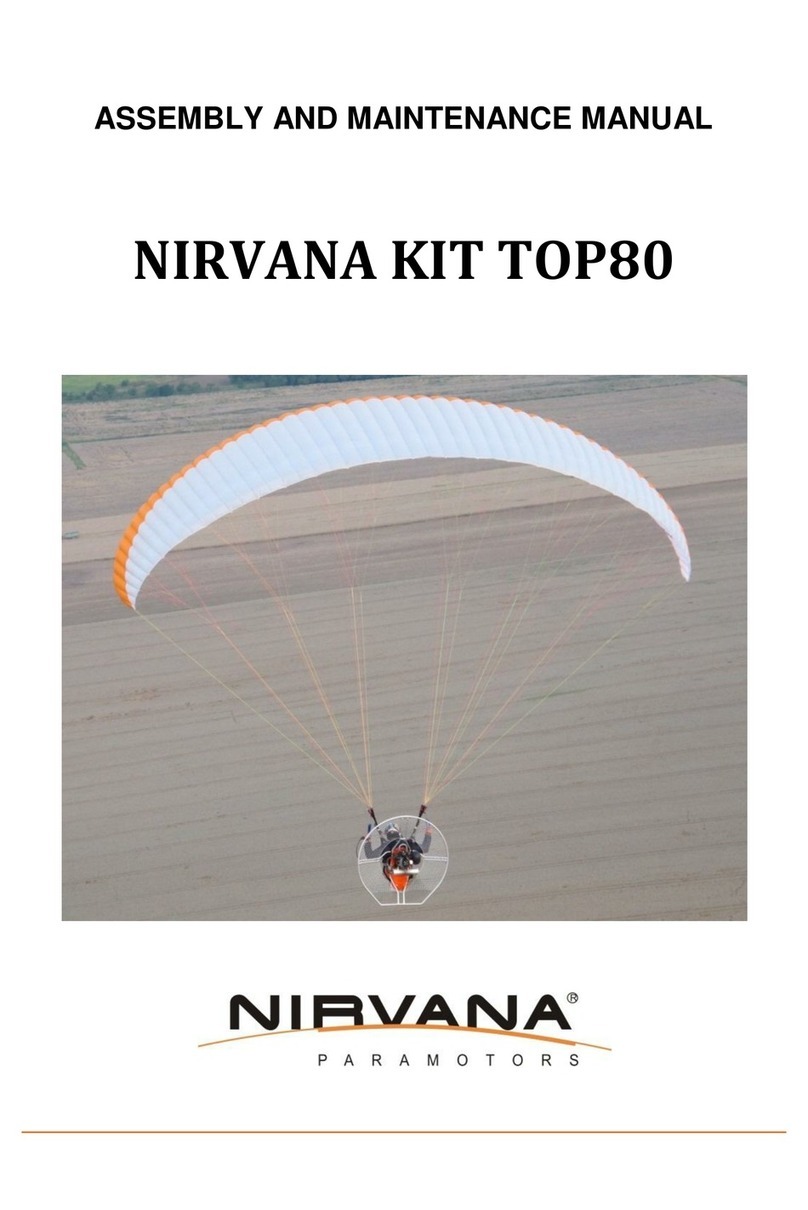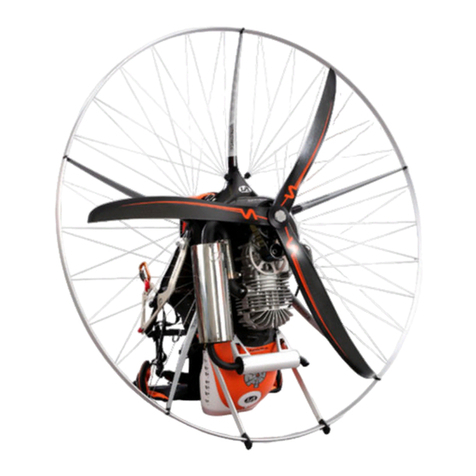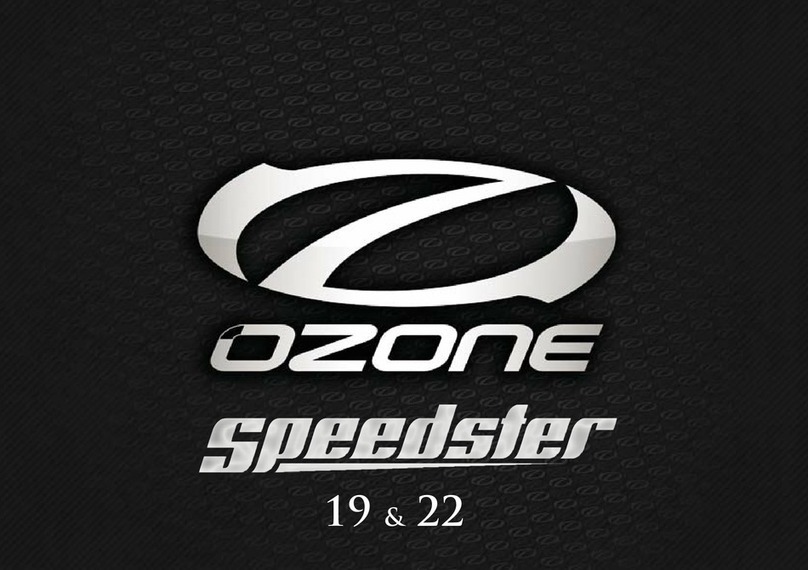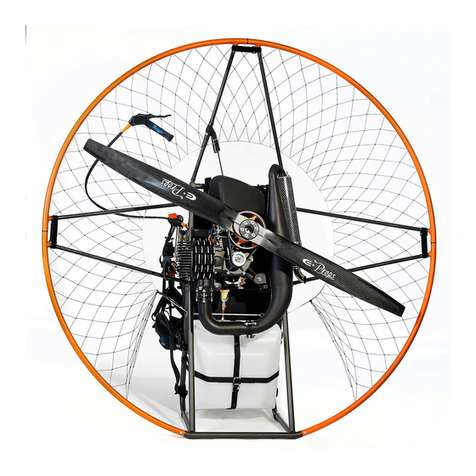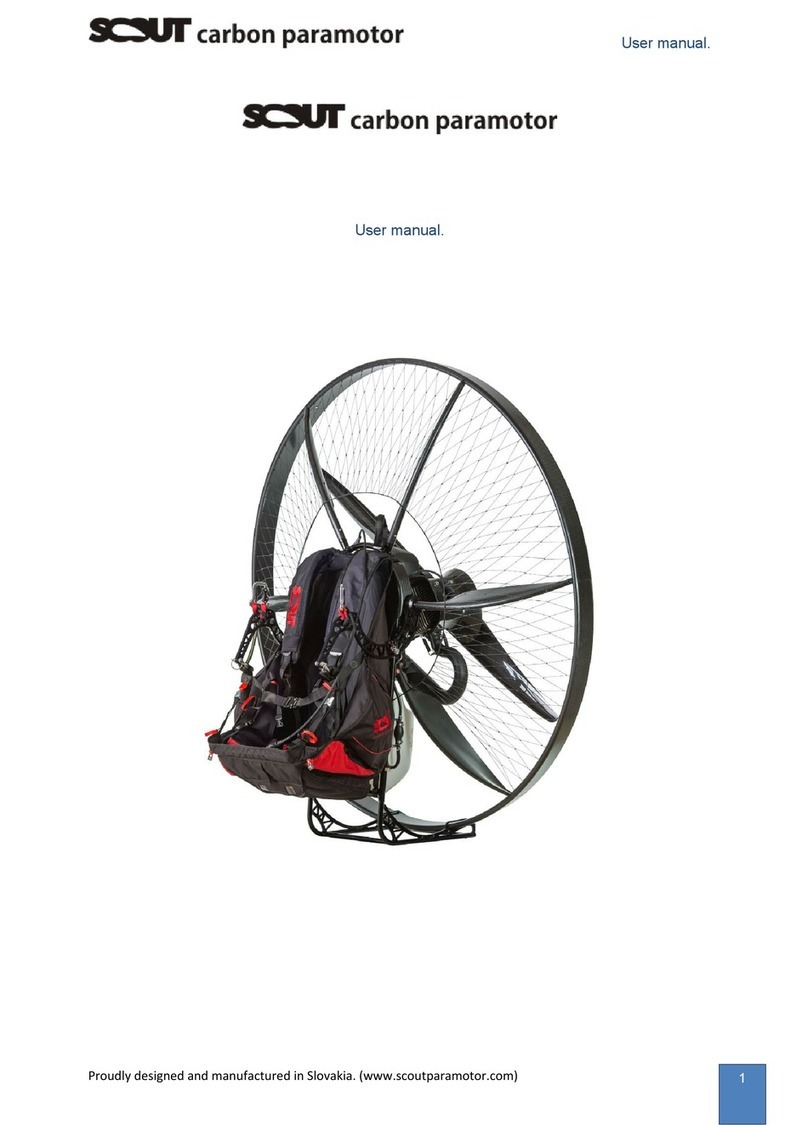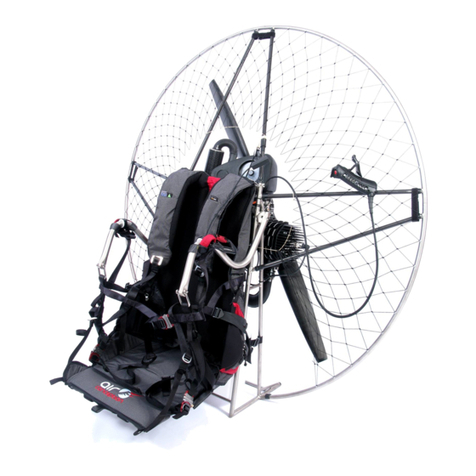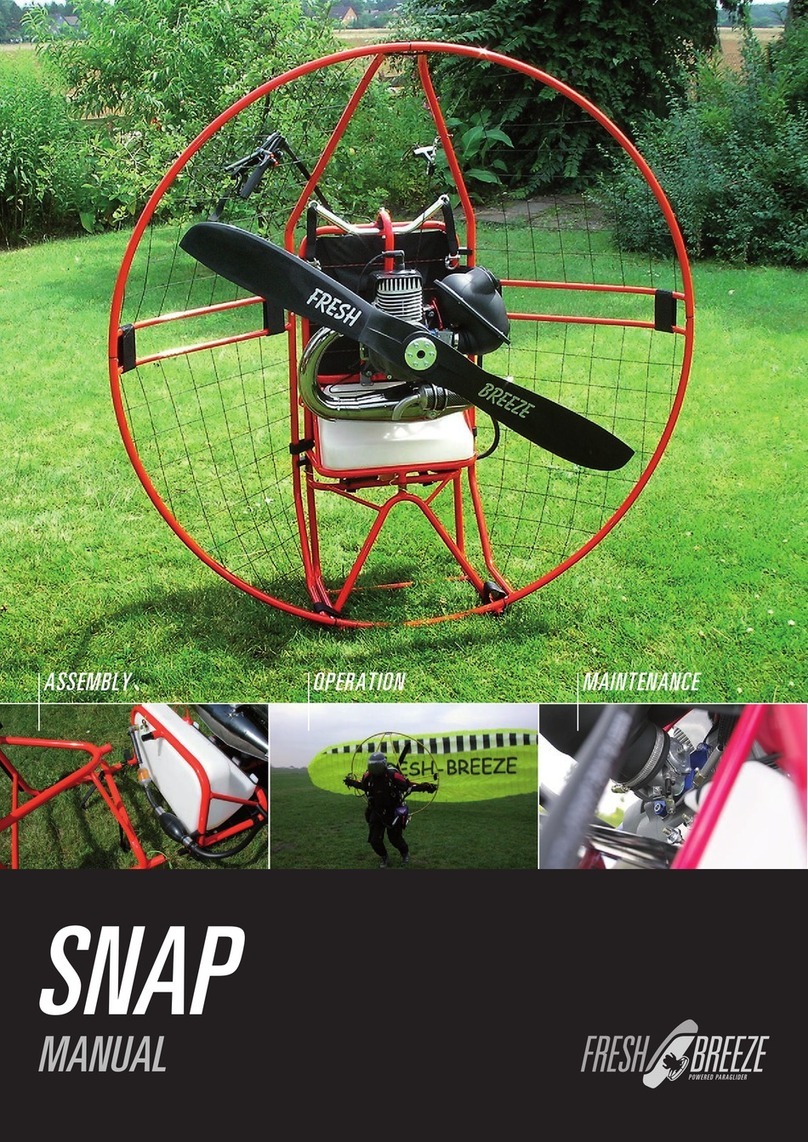Nirvana EASY Quick guide

ASSEMBLY AND MAINTENANCE MANUAL

last update 1.05.2009
2
CONTENT
Safe flying rules 4
Manual 5
Important notices 5
Amendments to the manual 5
Technical committee LAA R (Light Aircraft Association of zech republic) 6
Flight hand ook data 7
User’s – owner’s record 7
hange of the owner 7
Technical data 9
ontrols 10
Basic technical data of paraglider 10
Weights 10
Engine 11
Propeller 11
Rescue parachute system 12
Dimensions 13
Operating limitations 14
Speed
Driving unit limitations
Weight
Performance
Other limitations
Flight types
Emergency procedures 15
Engine failure
Fire
Vibrations
Using the rescue system
Normal procedures 16
Flight position adjustment 16
Pre-flight preparation (frame, prop, engine, battery, harness) 17
Pre-flight check 18
Engine test 19
Manual start 19
Refuelling 19
Takeoff 20
Landing 20

last update 1.05.2009
3
Engine tuning and maintenance 20
Running-in 20
Fuel and oils 21
arburettor settings 21
Propeller orientation setting 22
Propeller maintenance 22
Periodical maintenance 22
Faults and solutions 23
Transportation rules 24
Long time storage rules 24
Certificate LAA ČR for manufacture, service and testing of MPG 25
Type certificate – „Harness for MPG“ 26
Paramotor Components 29
Records 39
Service log 39
Record of bulletin implementations or mandatory changes 43
Daily operation records 44
Notes 58
Equipment 64
Warranty 65

last update 1.05.2009
4
Safe flying rules
Observe UL aircraft regulations.
Do not overestimate your pilot skills and never show off. Use open areas
for emergency landing training.
Watch the weather forecast carefully. Do not plan long flights, when storms,
fogs or frost are forecasted.
Watch fuel level (flight time and real consumption).
When hoosing the direction and height of your flight always consider
possibility of emergency landing.
Always fly with reserve of speed, particularly during all start and landing
manoeuvres.
Do not make any kind of aerobatics (e.g. total wingovers), even if you think,
your skills and flight characteristics of your MPG can manage it.
Do not underestimate the navigation and flight planning. Do not fly in unknown
area without proper preparation and equipment (map, navigation).
Fly only in good physical and mental condition.

last update 1.05.2009
5
MANUAL
1) This manual is written by the manufacturer of the MPG.
2) All records must be readable, permanent and none of the pages must be pulled
out.
3) This filled-in book is a part of technical documentation.
4) Total flight time, number of starts and latest issued mandatory bulletins must be
transferred to the new book.
5) Record only measured or certified data to the technical-operating records.
(After approval of commissioned inspector–technician)
6) The owner guarantees the accuracy of the operation records.
IMPORTANT NOTES
AMENDMENTS TO THE MANUAL
If there is change of flight rules or a required change to the construction of MPG,
announcements of these changes will be published in bulletins (e.g. in Pilot
magazine). Each owner of MPG must take an appropriate action and implement this
change and make record of this in the relevant part of this handbook.
E
Ev
ve
er
ry
y
o
ow
wn
ne
er
r,
,
u
us
se
er
r
a
an
nd
d
p
pi
il
lo
ot
t
o
of
f
t
th
hi
is
s
M
MP
PG
G
m
mu
us
st
t
t
th
ho
or
ro
ou
ug
gh
hl
ly
y
f
fa
am
mi
il
li
ia
ar
ri
iz
ze
e
t
th
he
em
ms
se
el
lv
ve
es
s
w
wi
it
th
h
t
th
hi
is
s
m
ma
an
nu
ua
al
l.
.
T
TH
HI
IS
S
P
PR
RO
OD
DU
UC
CT
T
D
DO
OE
ES
S
N
NO
OT
T
C
CO
OM
ME
E
U
UN
ND
DE
ER
R
C
CE
ER
RT
TI
IF
FI
IC
CA
AT
TI
IO
ON
N
O
OF
F
C
CI
IV
VI
IL
L
A
AV
VI
IA
AT
TI
IO
ON
N
A
AU
UT
TH
HO
OR
RI
IT
TY
Y
C
CR
R
A
AN
ND
D
I
IT
T
I
IS
S
O
OP
PA
AR
RA
AT
TE
ED
D
O
ON
N
U
US
SE
ER
RS
S
O
OW
WN
N
R
RI
IS
SK
K.
.
A
AL
LL
L
I
IN
NT
TE
EN
NT
TI
IO
ON
NA
AL
L
S
SP
PI
IR
RA
AL
LS
S,
,
F
FA
AL
LL
LS
S
A
AN
ND
D
A
AE
ER
RO
OB
BA
AT
TI
IC
CS
S
A
AR
RE
E
P
PR
RO
OH
HI
IB
BI
IT
TE
ED
D.
.
All construction changes to the MPG altering the original certified setup must be
authorised by commissioned inspector-technician, who registered this MPG.
Any damage to the MPG must be notified to manufacturer of relevant
inspector-technician, who recommends service, supervises the repair and
makes technical check of the MPG afterwards. He will make a record of
this in the documentation of the MPG.

last update 1.05.2009
6
TECHNICAL COMMITTEE LAA CR (
Light Aircraft Association of Czech Repu lic
)
represented by Mr. ……………………………………. certifies, that ,according to
authorisation from ivil aviation authority R given to test airworthiness of aircraft,
this MPG complies in construction, used materials, performance and
characteristics with the UL-2 directive, and belongs to the group:
Powered ParaGlider PPG
The name MPG – type
This MPG was awarded airworthiness certificate – type:
„Z“ – prototype, unique construction
„A“ – approved type of self-built construction
„P“ – approved type of professional made MPG
Type certificate is registered as ULL-01/2002 (see add.) by LAA R
Registration mark
Number of crewmembers 1
Date of registration
Inspector-technician stamp, signature ………………….
PPG
RODEO
Z

last update 1.05.2009
7
FLIGHT HANDBOOK RECORDS
USER´S - OWNER´S RECORD
MPG owner ………………………………………………………………………………….
Name …………………………………………………………………………………………
Address ………………………………………………………………………………………
ID number ….………………………………………………………………………...………
From – To (date) ..……………………………………………………………………..……
placed evidential mark OK - .…………………………………………………..………
hange of owner ………………………………………………………………….………
Name ………………………………………………………………………………………
Address .……………………………………………………………………………………
ID number .………………………………………………………………………...………
From – To (date) …………………………………………………………………..………
placed evidential mark OK - .…………………………………………………..………
anopy (manufacturer, type, category, work number, date of manufacture,
min. – max. flight weight, canopy weight):
manufacturer / type …………………………………………………………………………
category …………………………………………………………………………………
registration number …………………………………………………………………………
date of manuf. .………………………………………………………………………………
min. – max. flight weight ……………………………………………………………………
canopy weight ….……………………………………………………………………………
…………………………………………………………………………………………………

last update 1.05.2009
8
hange of owner ………………………………………………………………….………
Name ………………………………………………………………………………………
Address .……………………………………………………………………………………
ID number .………………………………………………………………………...………
From – To (date) …………………………………………………………………..………
placed evidential mark OK - .…………………………………………………..………
anopy (manufacturer, type, category, work number, date of manuf., min. – max.
flight weight, canopy weight):
manufacturer / type …………………………………………………………………………
category …………………………………………………………………………………
registration number ....………………………………………………………………………
date of manufacture ...………………………………………………………………………
min. – max. flight weight ……………………………………………………………………
canopy weight ….……………………………………………………………………………
…………………………………………………………………………………………………
hange of owner ………………………………………………………………….………
Name ………………………………………………………………………………………
Address .……………………………………………………………………………………
ID number .………………………………………………………………………...………
From – To (date) …………………………………………………………………..………
registration mark OK - ..............…………………………………………………..………
anopy (manufacturer, type, category, work number, date of manuf., min. – max.
flight weight, canopy weight):
manufacturer / type …………………………………………………………………………
category …………………………………………………………………………………
registration number …………………………………………………………………………
date of manufacture ...………………………………………………………………………
min. – max. flight weight ……………………………………………………………………
canopy weight ….……………………………………………………………………………

last update 1.05.2009
9
TECHNICAL DATA
TECHNICAL DATA MPG
rescue system
weight in fly
max.
min.
Harness
LEXX R Coli ri
NIRVANA
PARAMOTORS
Year of manuf.
Propeller
125 / 3
Helix, Germany
-
Manuf.num er
Engine
SKY 100
Sky Engines,
Italy
Name
Undercarriage
EASY
NIRVANA
PARAMOTORS
Manufacturer
Type, name
Manufacturer
Manuf.num er
Manuf. year
paraglider 1
paraglider 2
paraglider 3
paraglider 4

last update 1.05.2009
10
CONTROLS
Manual control
Pulling left brake MPG turns left and vice vera.
Pulling both breaks at the same time MPG brakes.
Throttle
In the left hand, pressing throttle lever increases thrust.
Ignition switch off
With left thumb, press and hold red button on the throttle.
Central ignition switch
With right hand, lower switch on the side of laminate part,. Ignition on – up, off –
down.
Starter utton
not available
Central starter switch
Not available
Rescue system
With right hand, bottom part of the harness, side container or front container
(depends on the harness type).
WEIGHT
paramotor, harness, carbines
empty weight according to UL – 2 24 kg
max. flight weight 150 kg

last update 1.05.2009
11
ENGINE
If the is not certified as an aircraft engine, it can fail any time! The pilot is
responsible for any consequences of engine failure !
two-stroke single-cylinder engine, watercooled, membrane carburettor Walbro WB8.
cylinder capacity 102 ccm
power on take off 18 PS / 10200 RPM
weight incl. liquids 13 kg
fuel (type, oct.rating) BA 95
consumption approx. 3 l/h
oil (type) 100% fully synthetic BARDAL KTS
the oil-petrol mixture 1 : 40
reduction (type, red.ratio) mechanical 1:4 oil lubricated
fuel tank capacity 10 l
PROPELLER
diameter material weight in configuration
1250 3blade composite 1200 g

last update 1.05.2009
12
Rescue parachute system
Type, manufacturer, manuf.number ………………………………………………..
…………………………………………………………..
Activation way …………………………………………………………..
Max. fall (m/s) …………………………………………………………..
With max. flight weight …………………………………………………………..
Position …………………………………………………………..
Battery (type, parameters)
Not available
Ignition NIRVANA CI
Not available
Output 16,8 V
Not available

last update 1.05.2009
13
DIMENSIONS
D D
1
L H T
1250 1450 450 750 450

last update 1.05.2009
14
OPERATING LIMITATIONS
Speed
Given by speed range of the canopy used.
Wind speed
According to canopy used. Do not take off and land with back wind.
Driving unit limitation
Mode
max. revolutions allowed 10600 rpm for max.. 5min at a time
max. constant revolutions 10200 rpm unlimited
Weight
min. pilot weight 45 kg
max. pilot weight 100 kg
max. weight in flight MPG 150 kg
empty weight MPG 24 kg
Performance
climb ratio approx. 1,5 m/s
service ceiling 3 500 m
flight range (depends on canopy used) cca 100 km
Other limitations
This paramotor is not certified for tandem flying.
anopy check period is set by the canopy manufacturer. We recommend first check
of the lines after 50-70 flying hours.
Flight types
Only daytime VFR flights are allowed
(visual reference flight). Other flight types are prohi ited.

last update 1.05.2009
15
EMERGENCY PROCEDURES
Engine failure (in height up to 200 m)
- lead the MPG into free flight
- in low height, land in the line of flight – try to avoid any barriers
- if you are high enough, land into an open area without any barriers, against the
wind if possible
Engine failure (in height over 200 m)
- lead the MPG into free flight
- check fuel condition
- in case of breaking fuel supply, try to restore it and start the engine
- if your paramotor has not got an electric starter, it do not start or your high is
under 200 m, choose suitable area for your landing and land as described
above.
Fire
- switch off the ignition
- do not try to start the engine
Vi rations
if abnormal vibrations appear it is necessary:
- to set engine revolutions to the mode, where vibrations are as small as
possible
- to do emergency landing
- if vibrations increase, land in the terrain with engine switched off.
Using the rescue system
In case of emergency or definitive loss of control of your paraglider, switch the
ignition off, right hand grasps the rescue parachute handle, pull and release it, and
throw it sideways behind yourself. The position of the handle depends on the
rescue parachute positioning – at the bottom, on the side or in the front (standard in
the front in a front container).

last update 1.05.2009
16
NORMAL PROCEDURES
All engines are tested before handover for about 10 min. We gave special attention
to all joining components. All screws nuts and rivets were carefully tightened and
secured by Loctite. It is important to check and tighten all screws on the cylinder
head and exhaust system after approx. 2 operating hours, when heat energy
causes theirs final positioning. After this check you can be sure, that your paramotor
is save and ready to fly.
Flight position adjustment
Flight position adjustment of all paramotor set must be done before the first flight.
The upper hang points for the karabiners are used for PPG flying. You should set
seat position, side trims, shoulder trims, to find comfortable position slightly leaning
back. We recommend to hang the seat so that it simulates the flight position and to
try shift from sitting to stand-up position before landing. It is important for future
smooth starts and safe landings.
The propeller must be in an angle of 5 degrees with vertical axis in flight position.
Each pilot must adjust the flight position for his high and weight.
PRE-FLIGHT PREPARATION
Paramotor assem ly
Frame
Take all components out of transport containers. Place the engine part horizontally
on the ground. Put the bottom quarter of the frame in the fixed pipe located in the
middle of the side of the laminate part, and turning fix it to the bottom hollow. Do the
same with the other bottom quarter. Then secure them together with velcro. Then
stand the engine up. Assemble the 2 upper quarters of the frame first, then slide
them partially into the pipes in the laminate part and finally to the bottom half of the
cage. Then assemble whole cage and secure it with all attached velcro belts.
Propeller
Put propeller on the reduction, put flange on it and secure it by four special screws
supplied. Tighten these by hand key in the order 1-4-2-5-3-6 with force of approx.
1 kg/m. Do not dent the propeller body by over tightening. We recommend turning
the propeller round once by hand to make sure, that it is attached correctly.
ATTNETION!
Never start the engine without a propeller!!!

last update 1.05.2009
17
Engine
Release the petrol tank cap to allow equalization of a pressure in the tank. Tighten
the cap again.
Battery
Insert charged battery (in the protective case) in the battery case in the laminate
part. heck the main starter switch. It should be OFF. Then connect leads and
close the battery case.
!! Never disconect battery from engine while in operation. There is a risk of damage
to the electronic ignition.
Harness
There is an anti-vibration airbag in the back part of the harness. Inflate it to approx.
30 % of its capacity and put it in the back pocket of the harness. lip the harness
to the paramotor firstly on a side, then at the top. arefully check the catches.
When locking upper buckles, pay attention to the rescue system belt, which has to
lead over above the buckles straps. Each of these buckles has bearing capacity of
300 kg and can not be unbuckled without simultaneously pressing both safety-
locks. The tubes at the side can not opened without simultaneously pressing safety
catch and pulling out the tube. Now You can be sure, you will not loose your
paramotor during the flight.
1) main glider attachment
2) side tubes for paramotor attachment
3) upper paramotor attachment points
4) rescue system attachment point
5) rescue system handle
6) front rescue system container attachment
7) straps for shoulder belt length setting
8) straps for sitting position setting

last update 1.05.2009
18
PRE-FLIGHT CHECK
cage intact, assembling, velcro
strings undamaged, tense
propeller orientation, screws tightening, intact, no damage
engine silent-blocks, carburettor and exhaust attachment
reduction screws
equipment general condition, fuel supply, el. contacts, switches,
spark-plug cable
fuel tank cup, tight
harness attach points – engine, pilot, paraglide
rescue system attached, safety catches
oil good oil-petrol mixture
petrol sufficiency for flight planed
engine test high revolutions, neutral, switch off
pilot helmet, shoes, warm clothes, gloves
other vario, tachometer, GPS, clock, radio
paraglider canopy, lines, loos ends

last update 1.05.2009
19
ENGINE TEST
When starting cold engine, repeatedly pres the petrol pump, until petrol comes out
through the air filter. Remove all small objects, which could be possibly drawn in by
the propeller, from immediate proximity of the paramotor. Loos parts of your (and
long hair) are equally dangerous.
No ody must stand dangerously close to starting engine,
especially not in the propeller’s plane of rotation.
Switch on the main switch on the right hand side. Grasp the engine handle firmly by
left hand, lean your knee against the laminate. Never hold the protective frame.
The engine gives thrust immediately after it is started. It is necessary to keep this in
mind and make sure, the engine switch off button is accessible.
Manual start
Turn the propeller behind engine compression. As no.1. take the throttle with the left
hand* together with the engine handle. Pull the start rope strongly (but smoothly).
Do not release the start rope, but let it smoothly retract back.
Electric start
Not available
After starting, warm up the engine for about 1 min in low and middle rpm, till it starts
accelerating. Then try idle revs, transition from min to max revs and back. Switch
the engine off.
* Why is the throttle in left hand?
Most of the pilots are right handed. So they hold the throttle in the left hand,
similarly like the cluch in the car on the left leg. And the right hand is free to
manipulate with tools, radios or cameras, which is much more motorically
demanding activity.
REFUELLING
Always refuel with the engine and all its electricity switched OFF. Fill the tank
through the filter and check the fuel purity. Make sure there is no fire around the
MPG, especially nobody smoking there. Use only fuel containers specifically
intended for fuel. Do not wear clothes, which create static electricity, during
refuelling your MPG. Keep the fuel out of the reach of children.
It is possible to watch fuel level during the flight, by the mirror placed on the string
in the harness pocket (or a parabolic plastic mirror fixed on the glove).

last update 1.05.2009
20
TAKEOFF
The pilot is supposed to a solve paramotor lessons in an official paramotor
schools and receive pilot licence for microlight category. The pilot is
responsi le for familiarizing yourself with flying rules and law in his country
or flying destination. This manual is not a su stitution of professional
paramotor course.
Make front start in front wind. Start to inflate the paraglider with your hand poised to
the sides and engine in idle revs. heck the canopy filling and line condition. Apply
full gas and run as fast as possible with your hands now above your head without
breaking the paraglider. Keep heading against the wind. When you reach the
takeoff speed, break the paraglider slightly and take off. Run until you fly. Do not sit
prematurely down into the harness and do not bounce to lift the canopy.
Release the breaks after take off and climb with full speed. This minimises the
danger of speed loss.
LANDING
arefully check the landing place, possible barriers and wind direction. Do always
land against the wind.
Press and hold the engine switch off button on the throttle till the engine stops in
high min 10 m above the ground. Get off the harness in approx. 5 m above the
ground. Land normally on your feet. Run if necessary. Put the canopy on the
ground to avoid the contact with hot engine parts.
ENGINE TUNING AND MAINTENANCE
RUNNING-IN
There are two reasons, why is engine running-in very important:
1) correct operation check in all rpm types
2) warming up the engine and final settling of all its parts
Don’t use full gas during first 5 flying hours, except for the take off (approx. 1 min at
a time). Vary the rpm levels during first flights. After this your engine will be ready to
fly without any limitations. The revolutions will increase by 300 rpm.
Table of contents
Other Nirvana Paramotor manuals
